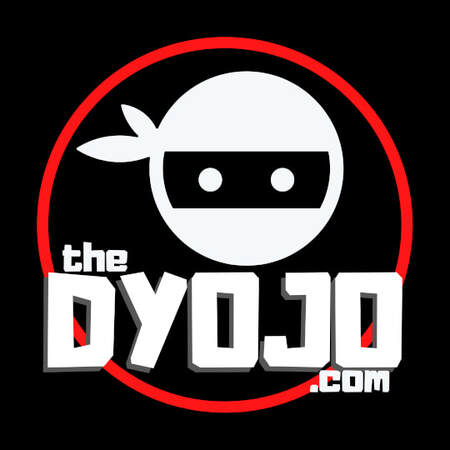|
Business owners and managers complain about the lack of quality applicants and employees who won't stick around. We take a look at some examples of terrible job descriptions for ways construction professionals can better navigate the recruitment process. We will also review some clips of hilariously bad job interviews for ways modern businesses can better connect with young professionals. IN EPISODE 113 of THE DYOJO PODCAST:
Clips were used in this Episode from * Too Apree on YouTube * TDP 49 with Al Erisman, author of The ServiceMaster Story * P2T: Preparing 2 Thrive in the Modern Workplace (book) Chapter 5 LAST EPISODE TDP 112 Creating a Competitive Business Advantage in 2024 NEXT EPISODE Join us as we discuss hard construction lessons learned from a failed nuclear power plant in Elma, Washington. Thursdays are for The DYOJO Podcast - helping contractors shorten their DANG learning curve. Join host Jon Isaacson as we explore contractor stories, experiences, and best practices to help listeners thrive in the skilled trades.
0 Comments
We take a trip down memory lane with a REPLAY plus of Episode 22 of The DYOJO Podcast. We discussed growing your business without compromising your values with guest Lex Sisney, author of Organizational Physics and Designed to Scale. Structuring Your Business for Growth and other topics we discuss with Lex Sisney in this BONUS Episode 0:00 Jon is traveling to Winter Break 4:12 Review of an old episode 8:51 Business structure vs. process 15:14 Organization design is not a democratic process 23:52 Creating change THANK YOU SPONSORS: Actionable Insights now has a Xactimate Profile similar to the Contractor & Carrier Profiles that come with Xactimate. Along with access to all the Insights Sheet Macros, the profile includes Actionable’s industry-standard default preferences that focus on accurate and transparent estimating. EPIC Estimates - Any estimate, anywhere, anytime. Let the award-winning EPIC Estimates help your team write the next Xactimate or Symbility estimate. Freeing your team up to do what their good at, while helping your business maximize productivity and profitability. Restoration Industry Association (RIA) - Connect and collaborate with your industry peers through the largest non-profit professional trade association dedicated to the unique plight of restoration contractors. Join us April 8-10, 2024 in Dallas for the Restoration Industry Association Convention and Industry Expo. Discounts are available for early registration. P2T: Preparing 2 Thrive in the Modern Workplace is the latest book from Jon Isaacson. P2T was written to help young professionals develop the mindsets and habits to thrive in the modern workplace. Employers are handing P2T out to new hires by the DOZENS. The DYOJO Podcast for Contractors
We put the question back to you in the DYOJO Podcast audience - where have some of your best hires come from? Some people hire from the franchise system thinking, "Well, if I'm in this franchise system, and they're in this franchise system, they could plug and play." Has this worked for you? A lot of contractors try to hire someone who has worked for a competitor. Expecting that they have some experience that will set everyone on the right foot. What have your results been with re-hires? I've shared many times before that my personal preference is I'd rather train new habits than retrain old habits. In this episode, I share some examples of doing this at multiple levels in a construction organization. From the technician level, superintendent, project manager, and even at the estimator level. This is what has worked best for my teams. Hear more about this process of recruiting, hiring, developing, and retaining quality young professionals in The DYOJO Podcast Episode 112. The DYOJO Podcast for Contractors
New episodes are released on Thursdays at 12:01am PST NEW BOOK - Resources for Young Pros
As a business owner or manager, are you stressed out, struggling to find ways to engage with young professionals in the workforce? P2T, the new book by Jon Isaacson will help businesses create a competitive advantage. My new book will help you better engage young professionals and articulate a pathway to success for new hires. P2T is a win-win for employers and employees. BUY NOW on Amazon Learn more - thedyojo.com/book5 If you don't have a leader that is invested in your growth, then you have to invest in yourself." - Nicole Humber, CEO of Bravo Restoration On Episode 110 of The DYOJO Podcast, we talked to Nicole Humber CEO of Bravo restoration, she's going to piggyback on the concept of reaching out to schools and talking to students about opportunities in the skilled trades. She says, "So I've been really involved in those schools coming back and either being a presenter and talking about our specific trade, or being a mentor for women, like women students that are interested, but not like, they only see male, so they think that's allowed. We have a couple of programs outside of schools that focus in on, you know, ages 16 to 24, or right after high school. And so I just get involved in those, you know, reaching out asking if I can be a mentor, or like, Hey, do you need anything like, what can I give you to help?" Generational Construction OutreachWe echo what Nicole is saying. And for anyone who hasn't experienced it, and we've had some badass ladies on our crews. It really is, there's no rhyme or reason it's not you're from this generation means that you're a hard worker, I've had people from older generations who have been lazier than young people. I've had young people kick butt and, you know, take in complex concepts quicker than others who've been doing it for a long period of time. So it's really, you know, finding the right people that are a culture fit for your organization. And if you look around, and the culture is pretty monolithic, you know, maybe it's a lead not, maybe it's a leadership issue, it's time to you yourself, need to get outside of your box, expand the parameters for finding new talent, and finding ways to make it open and inviting to not just because it's the right thing to do, but because it will exponentially grow and improve your company having more diverse influences. What are some of those words of encouragement for people that maybe are feeling like, Man, why am I doing this? Do I need to stick with it? How do will I break through barriers? Because whether it's a young person or various genders, or races, you know, there's all kinds of barriers to you know, especially a very traditional old school thinking industry. Becoming a Valuable EmployeeNicole Humber says, "I think that um, my biggest encouragement or advice would be just, you can only control what you can control what you do. You can't control what other people say or do or, or, and so it's like, what you can control is what you experience. And so when people are in these establishments, that they're like, I can't quite break through this barrier. I feel like there's a seat. A glass ceiling, I just I see it, but I can't get there. Invest in yourself. So invest in reading leadership books, invest in, you know, if you have to pay for your own IICRC classes do that. Do your research, become an expert in the industry where it makes it impossible for anyone to put the lid over you. If you don't have a leader that is invested in your growth, then you have to invest in yourself." On Episode 108 of The DYOJO Podcast, we are talking about crime and construction. Our main story centers around a burning truck, a missing contractor, and millions of dollars for housing developments being unaccounted for. Intro The DYOJO podcast Helping Contractors shorten their DANG learning curve Join host Jon Isaacson as we explore contractor stories, experiences, and best practices to help listeners thrive in the skilled trades. Prior - Related This isn’t the first time we’ve covered the intersection of construction and criminal activities on TDP. You may remember we did a four part series on RJC vs AISD - here’s a brief recap (video with Michelle Blevins from C&R Magazine / Restoration Today Podcast) RJC vs AISD Episodes Ep 98 - Part 4 - https://youtu.be/uJ_Z5nOOtNg?si=646hdBVa8iEDOPsB Ep 96- Part 3 - https://youtu.be/pZlJa5jz64s?si=qv-11QchnrnMmZZX Ep 93 - Part 2 - https://youtu.be/J8I-z9kSr8o?si=R9eCofvPIv-0kZkv Ep 92 - Part 1 - https://youtu.be/yjsJYljF9_0?si=bIsLLVUQnn7hNXfw New video https://youtu.be/0FyTqR6POQk?si=CahmeXjNh-eTAz2o Unfinished houses, open roofs: RJ Construction customers take their claims to bankruptcy court - https://www.keranews.org/business-economy/2022-09-12/unfinished-houses-open-roofs-rj-construction-customers-take-their-claims-to-bankruptcy-court Sponsors You know what the true crime is? Not checking out our sponsors… EPIC Esitmates - Any estimate, anywhere, anytime. Let the award-winning EPIC Estimates help your team write the next Xactimate or Symbility estimate. Freeing your team up to do what their good at, while helping your business maximize productivity and profitability. Restoration Industry Association (RIA) - Connect and collaborate with your industry peers through the largest non-profit professional trade association dedicated to the unique plight of restoration contractors. Join us April 8-10, 2024 in Dallas for the Restoration Industry Association Convention and Industry Expo. Discounts are available for early registration. Washington Business Brokers partners with business owners to confidentially explore selling their business with discreet, objective counsel as well as insight into market activity and comparable private transactions. Encircle - The only all-in-one field documentation solution. Visually document and present high-quality reports, so there are no questions asked. Their floorplan tool now integrates with Xactimate to create an ESX for estimating. So, You Want To Be A Project Manager? The third book from Jon Isaacson, written to help those wanting to advance their careers in the skilled trades. This book covers the mindsets and habits for construction project management with an emphasis on property restoration. Story Today's construction crime, developer Bret Detamore allegedly faked his disappearance for nearly a week and burned his bright yellow Dodge TRX as a potential cover-up for stealing hundreds of thousands, if not millions, from clients near Houston, Texas. We discuss the timeline and details of this story that started with his wife reporting him missing on Wednesday, June 21, 2023 and the fallout from the many unanswered questions related to this unique event. His business seemed to be thriving, according to those who know him. In his Instagram account in February, he showed what he termed “the 1st of 14 homes to be completed in 2023,” and he was driving a model of a Dodge Ram truck which sells with a low-end price tag of $84,555. TIMELINE Wed June 21, 2023 8:46am Wife reports 38 year old Contractor Brett Detamore missing to West University Place PD; a suburb near Houston, TX 100pm call from Houston PD to West U PD That same day Brett’s truck is found burning (pic) bright yellow dodge ram TRX in Bear Creek Park. According to WPD Chief Ken Walker, "The vehicle was severely burned. Most of the recognizing or identifying information had been destroyed. One of the HPD officers knew that they could find a secret VIN number. He found that number, ran it and it came back as a missing person’s vehicle. We were then notified where the vehicle was." The Houston Fire Department is investigating the arson case for Detamore's burnt truck and will determine if any charges will be filed. So far, HFD says no one has been ruled out as a suspect. Last week, the Harris County Precinct 1 and Precinct 5 Constables’ Offices and Texas Equusearch helped to conduct a search at the park last week but did not find Detamore. No shared evidence or discovery other than a male witness who claims to have observed a male walk away from the burning truck the morning of 6/21/23 Cameras from 6/21/23 at 4:21am (confirm) WPD cameras pick up Brett driving his truck, he is not following anyone or being followed Monday, June 26, 2023 Police still looking According to Fox 26 Houston - On Monday night, authorities say his wife received an e-mail from Detamore. "We had to verify it wasn’t a hoax. We had to verify it wasn’t somebody that was holding him hostage," Rosen said. "He was located in San Antonio Texas. He was located at a bus stop. He was then transported back to Harris County, voluntarily. We didn’t have to do anything other than we want to bring you back to Houston." Tue June 27, 2023 Brett is found in San Antonio at a bus stop According to Fox 26 Houston - Harris County Precinct 1 Constable Alan Rosen confirmed with a Facebook post that Brett Detamore, 38, has been located. Authorities say Detamore was taken to a hospital for medical evaluation and treatment. Constable Rosen expressed the family's gratitude for the support and requested privacy. Criminal charges? According to Fox 26 Houston - West University Police Chief Ken Walker says there was no foul play involved but believes his disappearance was pre-planned. "We are not investigating the missing person for a crime," he said. "We are still investigating people that may have been complicit in some things that were occurring, and we’ll continue to run those leads down." WPD has subpoenaed phone and financial records Civil lawsuits Detamore has not been charged criminally, but he and his development company were previously face two civil lawsuits. Detamore had two lawsuits — totaling about $325,000 — filed against him in New York after he allegedly defaulted on a pair of borrowing arrangements frequently used by strapped businesses seeking infusions of fast cash by signing away future revenues. Both cases were filed in Kings County, N.Y. by the same law firm on behalf of clients.
10/4/23 lawsuit The lawsuit, filed Wednesday, Oct. 4, in Harris County District Court, accuses Brett Detamore of abandoning home construction builds when he executed a plot to go into hiding. Now a $1,000,000 civil lawsuit filed by Zaffer Syed on Oct. 4 in Harris County seeks to fill in some of the gaps. Claim Before going into hiding, Detamore had already stolen money meant for the construction of homes, the lawsuit says. He falsified invoices and submitted them to a financing bank to acquire the money, according to the lawsuit. “Rather than use the funds for the homes, the stolen funds were used to support Brett Detamore’s lavish lifestyle,” the lawsuit says, alleging Detamore used money on Super Bowl and World Series tickets, high-priced vehicles and a home in Galveston worth more than $1 million. Response At attorney representing Detamore told KPRC the allegations are still being reviewed. “The events of the last few months have been tragic and unfortunately the subject of much public speculation and rumor,” a statement from the attorney read, according to KPRC. “Mr. Detamore is getting the help he needs, and the entire Detamore family requests privacy at this time.” SOURCES News clip - 2:43 https://youtu.be/WKyPz4JVurc?si=XJTJf3SmfnYXg3sD Police - 14:44 6/26/23 https://www.youtube.com/live/fNXcAt43cy8?si=-d8_VLDp0LEavF1n Police - 14:52 6/27/23 https://www.youtube.com/live/fNXcAt43cy8?si=fgieWBwOJElh6fQi Report - 6/26/23 https://www.fox26houston.com/news/missing-brett-detamore-search-continues-for-man-last-seen-in-west-university-place-truck-found-burned.amp Two Lawsuits prior - 6/26/23 https://www.essentialsnews.com/2-lawsuits-charge-missing-west-u-man-with-defaulting-on-cash-advances/ Found - 6/27/23 https://www.fox26houston.com/news/missing-west-university-resident-brett-detamore-found-alive Third suit - 10/9/23 https://lawandcrime.com/lawsuit/home-builder-jet-setted-around-blew-project-cash-on-super-bowl-and-world-series-before-faking-disappearance-and-setting-100000-truck-on-fire-lawsuit/ Ad - Encircle Closing Thoughts - Foul Play? Police said Detamore’s disappearance was pre-planned, and there were no indications of foul play. No “foul play” suspected Definition of foul play - “criminal violence or activity that results in a persons death.” Next Week - Missed a construction estimate by BILLIONS (with a B) What is the importance of telling your story as a construction business owner? Communicating your vision and values to your team and your community is an important component of achieving your goals as a contractor. Mari Borrero, CEO of American Abatement and Demolition, will be sharing the lessons she has learned in building her company. She will inspire participants of the Fall PNW Contractors Symposium and help them to better understand how to tell their stories as construction business owners. Contractor Story Telling Seattle WorkshopPresentation 4 Mari Borrero - American Abatement and Demolition (Auburn) Telling Your Story, Achieving Your Dreams Mari Borrero is the CEO of American Abatement and Demolition (AAD). Inspired by the dignity of work, the promise of education, and seizing every opportunity. Mari will share her story of building a business within the skilled trades, contributing to the local community, and the lessons learned during the growth process as a leader. She will share unique ways that contractors can tell their story to inspire team members and community partners to help achieve those visionary goals. Seattle Contractors Story Telling EventTHEME: Creating Value Within Construction Teams
Hosted by FoCKED and The DYOJO Podcast DATE: Tuesday, October 10, 2023 TIME: 8am - 130pm (Doors open at 730am) LOCATION: Tukwila, WA 98188 Please RSVP through Eventbrite Meeting sponsors:
730 Doors open and set up 805 Opening Theme - Creating Value Within Your Teams 815 Presentation 1 Ryan Hemmert - Washington Business Brokers (Seattle) Would You Buy Your Business? 900 Presentation 2 Geoff Lawson - Auburn School District Collaborative Productivity Goals 1005 Presentation 3 Peter Holmes - Encircle Communicating the WHY of Documentation 1050 Presentation 4 Mari Borrero - American Abatement (Kent) Telling Your Story, Achieving Your Dreams 1140 Closing Thoughts Panel with all speakers 1205 FREE Lunch, networking, and exhibits Sponsored by Luke Draeger - Aramsco (Tukwila) |
Words
The DYOJO - helping contractors shorten Archives
June 2024
Categories
All
EstimatingMarketingInsurance ClaimsLeadership |
|
| |||||||
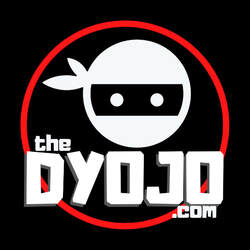

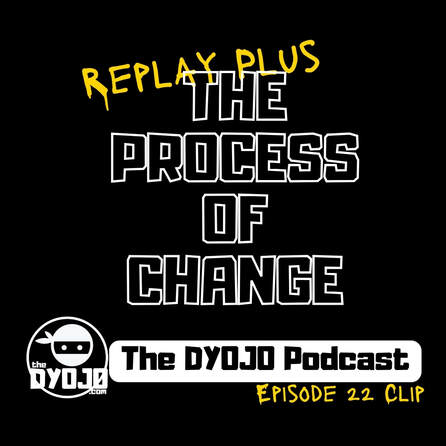
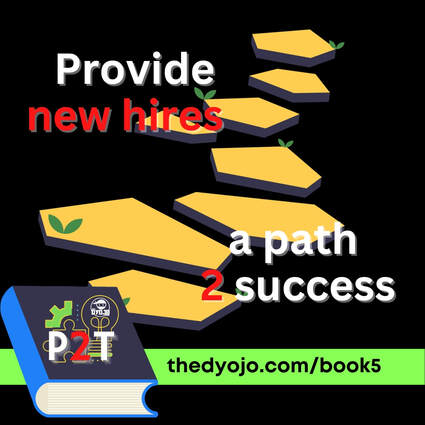
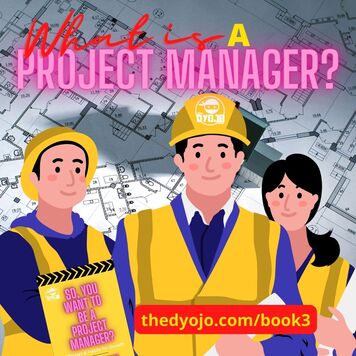
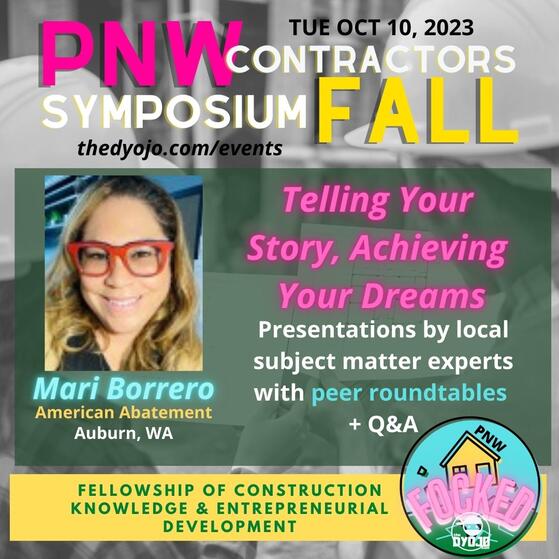
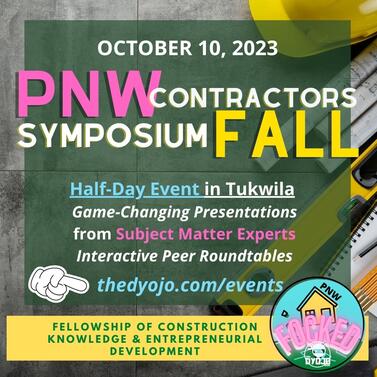

 RSS Feed
RSS Feed
